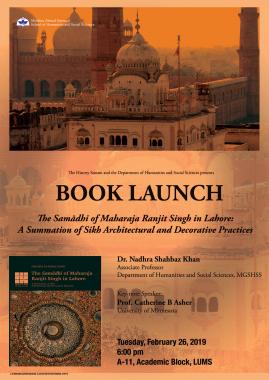
Dr. Nadhra Shahbaz Khan is Associate Professor of Art History at the Lahore University of Management Sciences, Lahore, Pakistan. A specialist in the history of art and architecture of the Punjab from the sixteenth to the early twentieth century, her research covers the visual and material culture of this region during the Mughal, Sikh, and colonial periods.
The History Stream and the Department of Humanities and Social Sciences has organised a book launch for Dr. Khan’s, The Samādhi of Maharaja Ranjit Singh in Lahore: A Summation of Sikh Architectural and Decorative Practices.
Date: Tuesday, February 26, 2019
Time: 6:00 pm
Venue: A-11, Academic Block, LUMS
The outstanding Sikh ruler Maharaja Ranjit Singh (r. 1799-1839) died ten years before the British annexation of the Punjab in 1849. His funerary monument or samādhi is located next to the Lahore Fort, where the Maharaja lived. The structure is the last state-funded project of the Lahore Darbār and represents a high point of nineteenth-century Sikh architecture, second only to the Golden Temple in Amritsar. The Samādhi of Maharaja Ranjit Singh in Lahore: A Summation of Sikh Architectural and Decorative Practices analyses the architecture and embellishments of the Maharaja’s samādhi, comparing them with contemporary and earlier Mughal, Rajput or Hindu practices. Media included are carving in red sandstone, white marble and wood, inlay in white marble, mirror mosaic and frescoes. The conclusion emphasises singular aspects of Sikh period art and architecture to establish a new cultural identity unique to Sikh aesthetics.
Keynote speaker for the event is Catherine B. Asher, a professor in the Department of Art History at the University of Minnesota. She has written extensively on Indian art and architecture since 1200 in a series of essays and books but has been particularly interested in the Mughals and how they were perceived in the 19th through 21st centuries. Her essay “Multiple Memories: Lives of the Taj Mahal,” in Crossing Cultures: Conflict / Migration / Convergence, (2008) is a recent reflection of this interest. Her initial interest in this project derives from her book, Architecture of Mughal India (1992) and her co-edited volume, Perceptions of South Asia’s Visual Past (1994). This theme and others are explored in her co-authored book, India before Europe (2006). Currently, Ms. Asher is working on the built environment of Jaipur from its foundation in the 18th century to the present.










